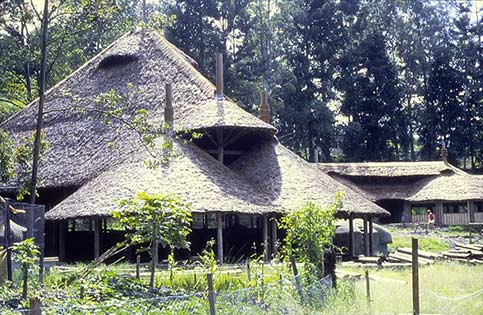 |
| How myths are born |
Its closest rival during my time in the Eastern Highlands was the Lantern Lodge. I used to play for my supper on the electric organ at the Lodge when the mood took me, not that it really mattered as the bar was always full and drinking was on most people's mind.
The Bird of Paradise had a gaggle of tribesmen and meris selling artifacts out the front as this was the main accommodation for the few tourists that passed through.
There were some good pieces to be had and recall a very nicely carved, clay pig whistle that I bought on the doorstep of The Bird. A good set of a black palm bow and arrows could also be bought although the best were to be found out in the villages, which is where I purchased mine.
The traditional bows are strung with a strip of bamboo and are very powerful. I tried mine out with a target in the back garden at Sinofi street and its impaled the cardboard target and supporting tree to a depth of ten centimetres.
The arrows are objects of beauty in their own right with various tips for hunting fish, birds and fighting other warriors. the fish arrows resembled a mini harpoon with their splayed bamboo tip bound with fibre.
Later I purchased a second ceremonial bow from a different part of PNG. This one was covered with woven orchid vine in red and white hues which made it quite a beautiful object.
I note that these days The Bird has joined the Quality chain which no doubt brings more bookings. It still gets good reviews from travellers. When I was there it was managed by an Australian and his Chinese wife who was very strict about maintaining standards.
They commissioned me to produce a portfolio of photographs of local scenes and activities to decorate the hotel's lounge.
Many tourists take in the much vaunted Asaro Mudmen tour while they are in Goroka. I happen to know that the following is a load of conceived bunkum!
"Tribal folklore records that centuries ago the warriors of Asaro were defeated in a tribal fight with a neighbouring village. Honour compelled the men to retaliate with a “payback” raid, and, to make themselves look fierce in the process, covered their bodies with grey mud. According to legend, the ruse worked, and their enemies fled at the sight of these ghostly apparitions"
The late Tara Monighan, who worked for TransNiugini Tours at the time, was one hand when this "legend" was born and she recounted it to me.
The Asaro people were trying to find a way to look distinctive at a singsing ceremony and it was an expatriate Aussie who suggested that the local clay deposits be used over a cane frame to make the now "famed" Asaro masks.
 The result as they say is the "stuff of legends" and has proved a nice little earner for the local tourism industry.
The result as they say is the "stuff of legends" and has proved a nice little earner for the local tourism industry.Far more interesting is the Raun Raun Theatre (right) which was being built in Goroka during my tenure. It is an interesting example of contemporary ferro cement construction and architecture and was completed in 1982.
The project architects were Paul Frame and Rex Addison.
The Raun Raun Theatre came into existence in 1975 at the suggestion of Professor Ulli Beier from the Insititute of PNG Studies.
"In early April, 1975, the Raun Raun Traveling Theatre was formed in Goroka with a grant from the National Cultural Council. A theatre truck was purchased with some help from the Goroka Rotary Club and housing was granted by District Authorities to accommodate drama students on the one hand and director/office on the other. The Theatre’s original function was to travel with ‘maket raun‘, a suggested scheme for taking public services, private sector activities and entertainment to a circuit of large village centres around the area."
Greg Murphy was the Director of Raun Raun Theatre and we had a close working relationship beween the School of Art and Design at Goroka Technical College and his company
The same ferro cement technique was applied to a number of houses elsewhere in the Highlands and I photographed several of these for an Air Niugini magazine article.


No comments:
Post a Comment